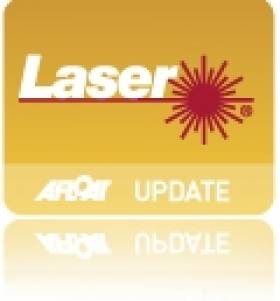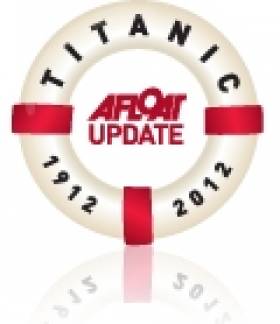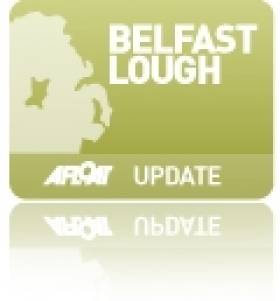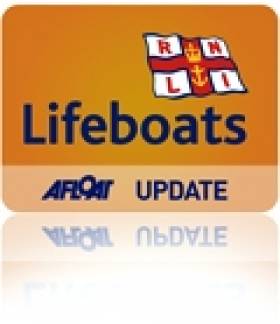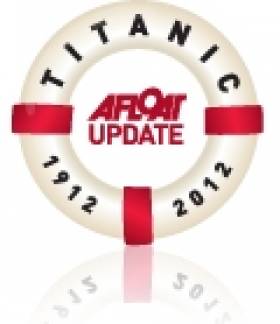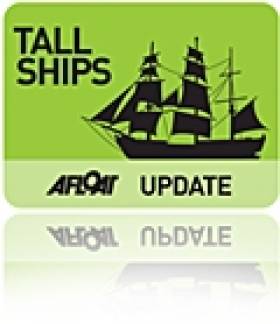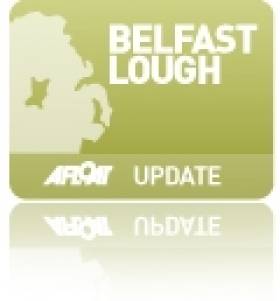Displaying items by tag: Belfast Lough
Squib Newcomers Are Light Wind Masters of Belfast Lough
Ross and Stuart Vaughan, newcomers to the Irish Squib fleet, are the 2013 Rodgers & Browne Squib Northern Champions.
Hosted over the first weekend of June at Royal North of Ireland Yacht Club, the event attracted 17 entries, with visitors from Killyleagh Yacht Club, Royal St George Yacht Club and Howth Yacht Club.
Light, tricky conditions prevailed throughout the weekend, with several major wind shifts adding to the difficulties. Race 1 was won by locals Denis Todd/Al Boston in Contender who had a good lead over fellow club mates and brothers, Ross and Stuart Vaughan, in Joint Venture and the father and daughter team of Fred and Holly Campbell in Halloween.
In Race 2 the wind increased significantly and Greg Bell/Leah Anderson on Prodigal led throughout the race to secure the gun at the finish. Joint Venture managed another second, beating last year's winners Davy Eccles/Phil Hutchinson on Inshallah, who were third.
With the wind continuing to clock around to the right, the third race was initially abandoned as a further 100 degree shift to the right materialised. The restarted race saw Halloween take line honours, followed by Inshallah and visitors from Howth, Jonathan Craig/Hazel Ruane on Kerfuffle securing third place.
Having completed the three races scheduled for that day, the fleet returned to the shore for a night of revelry.
Bleary eyed, the hardened Squibbers appeared one by one on the Sunday morning to be faced with minimal breeze, as predicted. After some persuasion the fleet made its way out to the inevitable postponement. However, experienced PRO Nigel Kearney's patience was rewarded when the sea breeze started to fill in after midday and, after an abandoned start as the wind settled, he got two of the races away in steady breeze.
Joint Venture added to its impressive score card with its first win of the event. Previous Northern Champions, Gordon Patterson/Ross Nolan on Quickstep III, secured a second place with David Mellor/Leandre McCollum on Conquest taking third.
With the time limit for a final start fast approaching, it was clear that the fifth race would be the last and so the PRO took opportunity to extend it to three rounds, ensuring that the fleet got value for money. Prodigal got a great start, and led from start to finish. Inshallah and Halloween took second and third place respectively.
Fourth place was enough for the Vaughan brothers to return to the club moorings as Northern Champions.
Overall:
1st: Joint Venture: Ross and Stuart Vaughan, RNIYC
2nd: Prodigal: Greg Bell and Leah Anderson, RNIYC
3rd: Halloween: Fred and Holly Campbell, RNIYC
Multiple Irish National Champion Gareth Flannigan is one of the leading contenders for the Laser Masters title when it is sailed on his home waters of Ballyholme Yacht Club in three weeks time (25/26th May).
Visitors from Scotland and England are swelling the fleet at Ballyholme to over 50 entries.
Four entries leave for warm weather training in Lake Garda this weekend, a sign of how competitive Laser sailing is in Ireland right now.
Titanic Belfast Is 'Euro Tourism Success Story'
#Titanic - Titanic Belfast is second only to the Guinness Storehouse in terms of visitor numbers in its first year, as The Irish Times reports.
NI Deputy First Minister Martin McGuinness, who joined First Minister Peter Robinson at an event to mark the first anniversary of the Belfast Lough-side visitor centre's opening, said the total of 807,340 visitors exceeded expectations and is “an outstanding European tourism success story”.
Operators of the Titanic Visitor Experience at Titanic Belfast said people from 128 different countries had come to see the exhibits, including Britain's Queen Elizabeth II and noted Titanic enthusiast James Cameron.
The Irish Times has more on the story HERE.
RNLI Crews Assist Windsurfer, Stricken Fishing Boat in Co Down
#RNLI - Portaferry RNLI rescued a windsurfer who got into difficulty off the Co Down coast yesterday (16 April).
The volunteer crew launched their inshore lifeboat before 5pm yesterday evening to go the aid of the injured windsurfer reported to be in the area of Pig Island, a small island in Strangford Lough close to Newtownards Sailing Club.
The weather at the time was described as blowing slight to moderate winds with good visibility.
The crew was on scene at 5.15pm where they found the man on Pig Island accompanied by two other men. The windsurfer, who was suffering from a shoulder injury, was transferred to the lifeboat and made comfortable before being taken to the sailing club, where he was then transferred into the care of the coastguard and passed to the ambulance service to be taken to hospital.
Speaking after the rescue, Portaferry RNLI lifeboat operations manager Brian Bailie said: "As the charity that saves lives at sea, we will always respond to any call for help where someone is in danger.
"Strangford Lough is a popular destination for a wide range of water sport enthusiasts and it is important that they take all necessary precautions when using the lough.
"As we are all aware, accidents can and do happen and it is at such times that the work carried out by the volunteer crews of the RNLI is so important."
Elsewhere in Co Down yesterday, Bangor and Donaghadee RNLI assisted a fisherman whose 28ft commercial fishing boat experienced engine failure.
The crew quickly located the disabled boat one mile west of the Copeland Islands at the mouth of Belfast Lough yesterday morning after 11.15am.
With the vessel drifting closer to the island shores and the wind gusting gale force eight, a tow line was quickly rigged and passed to the fishing boat. Bangor RNLI was escorted by Donaghadee RNLI's all-weather lifeboat as it towed the fishing vessel to the safety of Bangor Harbour.
Bangor RNLI volunteer helm Peter Scott, who was involved in this rescue, said: "Engine failure close to shore could lead to a life threatening situation. We always urge everyone going to sea to make sure their electrical systems and engine are well maintained and in good working order. A good anchor and chain should always be carried as part of essential safety equipment.
"We are glad the skipper of this vessel is now safely ashore," he added.
#ballyholme – Ballyholme Yacht Club will be holding the first keelboat series in Ireland run under the new NHC on Saturday afternoons in May.
Billed as light hearted racing with a bit of craic, the series is used to get the local keelboats up to speed quickly for the upcoming Sigma Nationals at RUYC and other upcoming events.
More information is downloadable below.
There has been a lot of talk about the new National Handicap for Cruisers (NHC) and information and the initial Base Number list is now available on the RYA Website in the Racing Section.
To give everyone a chance to hear more about the new system RYANI have been able to arrange for Bas Edmonds and Alan Wibroe, from the RYA Technical Department, to come to Northern Ireland and tell us more about how it works and how your Club can use it.
They will make their presentation at Ballyholme Yacht Club on Wednesday 17th April at 7:30 pm. The talk will last approximately one and a half hours and there will then be time for a question and answer session.
This FREE talk is open to everyone with an interest in Cruiser Handicap racing including Club Sailing Secretaries, Handicap Secretaries, Race Officers and Scorers and, of course, Owners and Crew.
If you do intend to come to the talk in Ballyholme YC on 17th please email [email protected] or [email protected]
Busy Days For RNLI Lifeboats In Co Down
#RNLI - Newcastle RNLI’s always-on-call lifeboat crew had to abandon their buckets and sponges during a fundraising car wash at the weekend to respond to an emergency at the Co Down town’s harbour.
The RNLI volunteers were busily soaping and rinsing cars for their annual Easter fundraiser on Saturday when they were alerted to a woman in trouble in the freezing water a few yards from one of the piers.
The car wash was immediately abandoned and within minutes the inshore lifeboat Aldergrove II was launched and rushed to the woman’s aid.
At the same time, crew member Shane Rice grabbed a lifebelt from the pier and jumped into the water to assist the woman. He kept her afloat while the Aldergrove II came alongside.
The woman was helped into the rescue inflatable, wrapped in blankets to prevent hypothermia, and taken back to shore where an ambulance was waiting to take her to hospital.
Newcastle RNLI’s deputy launching authority Clifford Moorehead said afterwards: "The lifeboat crew are always ready to respond in an instant to any emergency. It is fortunate that the car wash was in progress at the time and the crew members were on hand to swiftly deal with this case.
"After the rescue the crew members came back to the harbour and resumed their car wash. It’s just all in a day’s work for the RNLI."
It wasn't the only callout of the weekend for the RNLI in Co Down, as Bangor RNLI assisted a lone sailor who got into difficulty on a sailing dinghy Easter Sunday.
At 1.10pm the volunteer lifeboat crew received an urgent request from Belfast Coastguard to launch the lifeboat and rescue one person from a 17ft dinghy.
The sailing dinghy had reportedly gone aground on ‘Cockle Island’ off Groomsport Harbour on the southern shores of Belfast Lough.
Upon arrival at the scene, the volunteer crew found that the occupant onboard the dinghy had been assisted by another boat owner and the vessel had been safely tied to a mooring buoy.
Meanwhile, last Wednesday evening Portaferry RNLI was launched to reports that red flares has been sighted on Strangford Lough off Kircubbin in Co Down.
They were joined by a coastguard team that searched the shoreline and after some time recovered a spent flare casing. The inshore lifeboat and its volunteer crew were stood down after a number of hours with the callout proving to be a false alarm.
Portaferry RNLI lifeboat operations manager Brian Bailie said: "A member of the public acted in good faith ... alerting the emergency services to what they understood to be a distress flare on the lough."
He reiterated that flares "should only be used in emergency situations".
Ballyholme Ice Breaker Attracts London Olympic Duo
#ballyholme – Thankfully the wind had dropped a bit from Saturday and racing was definitely on. The sun even made an appearance which did warm things up a bit and the breeze held out to give us a great sail for race 6 in the second part of the Ice-breaker Series. Some intrepid travellers had gone to Rome to support Ireland!.. and a few others took off for the bank holiday weekend.
The sensible people stayed at home and had a feast of rugby on the Saturday and then enjoyed a lovely Sunday afternoon on the water...followed by a few beers.
Robin Gray attempted to give us another windward leeward course but at the start the wind was not really playing ball. It was shifting and looked like it may drop, so wisely he reverted to normal course.
The Laser fleet got underway in a relatively calm start...... apart from Brian Spence who got a little excited and started his race before the gun........ He returned to start correctly but was caught by the flag!
Everyone else got away and the first beat was to the North East Mark. Most of the fleet dived to the far shore making their way up the right hand side of the beat. The wind was shifting a bit so their were gains and losses to be made. At the windward mark the leading boats had a familiar ring to them. Gareth Flannigan, Chris Boyd and David Fletcher. Also in the front of the fleet was Charlie Westhurst. Charlie was right up with the leaders and showed no sign of slipping back. Keith Storey and Paddy Brow were also going well and with Conor Brown and Andrew Kennedy this made up the sharp end of the fleet. Alex Wards dulcet tones could be heard near the front of the fleet. He was storming his way round the course and was attempting to sabotage Charlie's good race.
Hammy Baker was lurking just behind the front 3 and on the last lap he decided to play his joker. He took the opposite side of the beat and hit the left hand corner. Low and behold there was a favourable wind shift and he arrived at the windward mark on the last lap way ahead of anyone else. You could see amusement on the faces of the 3 guys who were leading up until that point.....not.
So Hammy held the lead to take his first bullet of this series and also put himself into 1st place overall. He has had a great run of results since Christmas and is putting a bit of pressure on Flipper. He is one point behind Hammy at this stage with Chris Boyd 3 points further back on 17 and David Fletcher on 20. So with 2 races left it will be a very close call between the top 4.
Mike Kimber, Keith Storey and Peter Kennedy are also having a good second series. Peter would be putting a lot more pressure on the top guys if he had managed a few more races.
In the Laser Radial fleet Jessica Rutherford recorded her second bullet of the series and moved to 1st place overall, on equal points with Tim Brow. This will make a very interesting end to this fleets series as Ryan Glyn is just 3 points behind in 3rd place and Sarah Eames in 4th
Another Rutherford leads the 4.7 fleet. Rebekah had another first on Sunday which moves her 4 points clear of Sean Ritson.
In the large dinghy fleet the "Olympic duo" of Ryan Seaton and Mat McGovern are just holding off the formidable challenge of Wiclif McCready by 1 point with Liam Donnelly 5 points further back.
Adrian Allen is again leading the way in the multi hulls with a 7 point lead over Dave Anderson.
The topper fleet is being lead by Ben Martin who is 8 points clear of Emma McKnight and 11 clear of Mark McDonough.
Only two races to go as we take a break for a week on Easter Sunday. Final race is 7th April when we plan to have a BBQ prior to the Prizegiving at 6.00pm.
Also - well done to Robbie Gilmore from SLYC and Ballyholme YC with his second place in the Europa Cup Laser Radials at Lake Garda. The RYANI Laser Radial Squad have been training hard at Ballyholme over the weekend and recent months - the first event at Baltimore will be very interesting.
'Titanic II' Plans Unveiled By Mining Millionaire
#Titanic - An Australian mining millionaire has unveiled his plans to resurrect the Titanic for the 21st century, as The Irish Times reports.
Clive Palmer wants to build a new version of the ill-fated cruise liner - to be dubbed Titanic II - recreating the style and comfort of the original, but with modern navigational instruments and enough lifeboats for all on board.
"Titanic was a ship of dreams and Titanic II promises to be the ship where dreams come true," he told reporters at the Ritz Hotel in London last week.
Already he claims that 40,000 people have enquired about passage, and 16 individuals have offered $1 million each for a state room on the new liner for its maiden voyage after the vessel is completed in late 2016.
Titanic II will not be an exact replica of its predecessor, as it's planned to be four metres wider to provide greater stability, as well as featuring stabilisers and reverse propellers to provide for a more comfortable voyage.
It will also not be built at Harland & Wolff, the Belfast Lough shipyards that constructed the original White Star Line vessel, instead being contracted to the world record-holding large ship facilities at Jiangsu in China.
The Irish Times has more on the story HERE.
HMS Bounty: The Tall Ship That Should Never Have Sailed?
#TallShips - What was the HMS Bounty doing in the middle of Hurricane Sandy? It's a question that Kathryn Miles - author of a book on the history of the Jeanie Johnston - attempts to answer for Outside magazine.
As reported last October on Afloat.ie, the tall ship replica of the 18th-century square-rigged vessel - and a previous visitor to Irish shores - was sunk in the Atlantic some 100 miles off Cape Fear, forcing its crew into liferafts.
The ship's captain Robin Walbridge went missing in the incident and is presumed dead.
According to Outside, the ship has has a tumultuous history since its construction for the 1960 Hollywood film Mutiny On The Bounty starring Marlon Brando - weathering life as a seaside attraction at a Florida resort town, and as an extra in two of the Pirates of the Caribbean movies.
Since 1995 it was skippered by Walbridge, who "worked tirelessly to preserve the vessel" and took her as far and wide as the Great Lakes, the Panama Canal and Europe - including visits to Cork Harbour in 2009 and Belfast Lough in 2011, reflecting the original vessel's Irish connections (Captain William Bligh designed the North Bull Wall and surveyed Dublin Bay some years after the infamous mutiny).
But preservation requires funding, and it's that struggle for funding that may have encouraged the captain to push the limits of his vessel and its crew.
Outside has much more on the story HERE.
RYA Volunteer Awards for Belfast Lough Sailors
#RYAAwards - Two sailors from Northern Ireland have received awards from the Royal Yachting Association for their voluntary work, as the Carrickfergus Times reports.
Belfast Lough locals Sheela Lewis from Whitehead received Karl Blythe from Carrickfergus were among 56 people commended by Britain's Princess Royal at the RYA Volunteer Awards in London recently.
Lewis, the first female commodore of the County Antrim Yacht Club, was presented with the Lifetime Commitment Award for her hard work in developing the small club's sailing courses.
And Blythe was nominated by Belfast Lough Sailability for the Youth Award for his dedication to helping others get into sailing and promoting the club online, even while facing the challenges of his autism spectrum disorder.
“I really enjoy helping out with Belfast Lough Sailability and don’t think I do anything more special than any other volunteer," said the 19-year-old. "I really enjoy getting involved, not only with the sailing and on-the-water activities but also helping behind the scenes."



























